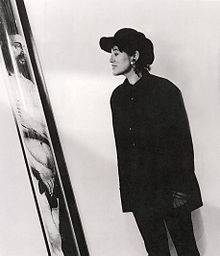Paloma Navares

Paloma Navares (born 1947) is an interdisciplinary Spanish artist who combines sculpture, photography, video and audio in her installations.[1] Recurring themes in her work are the feminine condition, the historical representation of women through art, the critical analysis of the canon, madness, beauty and aging.[2][3]
Biography
Navares was born in Burgos, Spain.[1] She lives and works in Madrid and Alicante in Spain.[citation needed]
In 1985-1986 she created Seravan; A Song for a Fallen Tree and Origin and Moonlit Nights which were mainly exhibited in art centers and museums in Europe. In 1997-98 she did the scenery design for The House of Forgetfulness and Bodies of Shadow and Light with the company Lanonima Imperial. In 2004 she did a scenery design project for the opera Juana by Enric Palomar, first performed in 2005 at the Opera House in Halle. Since she began her art career in 1979 she has exhibited in more than one hundred venues around the world and her work has been seen in fairs and art biennials.

In 2018 Paloma Navares was awarded the MAV Price (Women in the Visual Arts) recognizing her contributions in a long career.[4]
In 2024, the ENAIRE Foundation awarded her with the Trayectoria Prize, “for a life dedicated to artistic creation, exploring the limits of a theme that, in a perceptive way at the beginning and decisively later, becomes a mantra without seeking it: the feminine universe.” The ENAIRE Foundation also organized a solo retrospective exhibition of her work at the Royal Botanical Garden of Madrid.[5]
Publications (selection)
- Travesia. Paisajes de interior.1987-2010. Universidad Complutense de Madrid (in English and Spanish). 2011. ISBN 978-84-96701-43-4.
- Otros paramos. AECID (in English and Spanish). 2009. ISBN 978-84-8347-115-9.
- Dell'Anima ferita. Comune di Sassuolo (in Italian and Spanish). 2007. ISBN 978-84-88252-58-6.
- Del alma herida. Instituto Cervantes (in English and Spanish). 2006. ISBN 84-88252-58-7.
- Nueva tecnología. Nueva iconografía. Nueva fotografía. Fotografía de los años 80 y 90 en la colección del Museo Nacional Centro de Arte Reina Sofía. Juan March Foundation Art and Science Publishing House (in Spanish). 2004–2005. ISBN 84-7075-522-6.
- Travesía 90–03. CAB Art Center of the Burgos Savings Bank (in English and Spanish). 2004. ISBN 84-87152-93-7.
- Espacios Fronterizos. Pilar and Joan Miró Foundation (in Catalan). 2003–2004. ISBN 84-89034-64-8.
- Stand by. Municipal Museum of Málaga (in English and Spanish). 2002–2003. ISBN 84-87035-93-0.
- Al Filo. Art and Technology Foundation of Telefonica (in English and Spanish). 2003. ISBN 84-89884-40-4.
- Milenia, del corazón y el artificio. Residenzgalerie Salzburg (in English and German). 1999. OCLC 902205266.
- Pendientes del corazón. Town Hall of Girona and the Caixa de Catalunya Foundation (in Catalan and English). 1998. Dip. Legal. GI-833/98.
- Recipiente de lágrimas. Sa Nostra Center (in Catalan, English and Spanish). 1998. ISBN 84-89632-61-8.
- Luces de hibernación. Junta de Castilla y León (in Spanish). 1997. ISBN 84-7846-558-8.
- Fragmentos del jardín de la memoria. Telefonica Art and Technology Foundation. (in English and Spanish). 1996. ISBN 84-89043-05-1.
- Nymphen, Venus, Evas und andere Musen. Overbeck-Gesellsghaft. Lübeck. (in German and Spanish). 1996.
- Otros Paraísos. Museum Moderner Kunst, Stiftung Ludwig. Vienna. (in German and Spanish). 1992. ISBN 84-7952-077-9.
References
- ^ a b "Exposición - Paloma Navares. From the garden of memory".
- ^ "Thyssen Museum presents the painting of Paloma Navares". 2018-03-08.
- ^ "How the Female Artists of Madrid Are Finally Getting Their Due".
- ^ "Vii Premios Mav. Premiadas 2018 | Mav".
- ^ "Paloma Navares, Premio Trayectoria 2024 Fundación ENAIRE".
- GRAS, Menene. "Aprovecha que llueve". Archived from the original on 2012-09-30. Retrieved 2011-05-20.
- NÚÑEZ, Gonzalo (7 October 2008). "Del alma herida: un canto a las escritoras suicidas". Instituto Cervantes de Praga.
- MARIN MEDINA, Jose. "Paloma Navares, el arte y lo psiquico". El Cultural.es El Mundo.
- LAMBERT, Xavier. "Corps, pneuma et tekhné". visuelimage.com.
- ROMERO FERNÁNDEA, Irene. "Autorretratos: la desmitificación del cuerpo en la fotografía del siglo XX" (PDF). El genio maligno. Revista de humanidades y ciencias sociales, nº 11.
- MANTECÓN MORENO, Marta (2010-01-12). """Tú tampoco tienes nada". Arte feminista y de género en la España de los 90"". Anales de Historia del Arte. Anales de la Historia del Arte. Volumen extraordinario. UCM.: 155–167.
- MARTÍN CIRIQUIÁN, Elena. "Identidad, cuerpo y nuevas tecnologías: o cómo ven las artistas españolas del último tercio del siglo XX a la mujer contemporánea" (PDF). Universidad de Alicante. Archived from the original (PDF) on 2013-06-16. Retrieved 2014-01-20.
- RAMÍREZ, Juan Antonio. "Automodelo e identidad quebrada". Exit, 10.
- DE DIEGO, Estrella (2012-03-10). ""Arte firmado por mujeres"". El País. Cultura. El País. 10 de marzo de 2012.
- EXPÓSITO, Marcelo. ""Feminismos y políticas de género" - Desacuerdos expo 0.2. Hipótesis para una exposición" (PDF).
- FERRERO MERINO, Valentín. Venus, paraísos, Evas y artificios: el lenguaje híbrido como aportación al discurso de género en la creación artística contemporánea. Análisis de la preproducción y producción en la obra de Paloma Navares. 1986-1996. Universidad Miguel Hernández de Elche. Altea.
- HERNÁNDEZ, Carmen. "Desde el cuerpo. Alegorías de lo femenino".
- OLIVARES, Rosa. "¿Quién soy yo?". Exit: imagen y cultura, Nº. 10.
- EL PAÍS. "Reviews and reports". El País.com.
